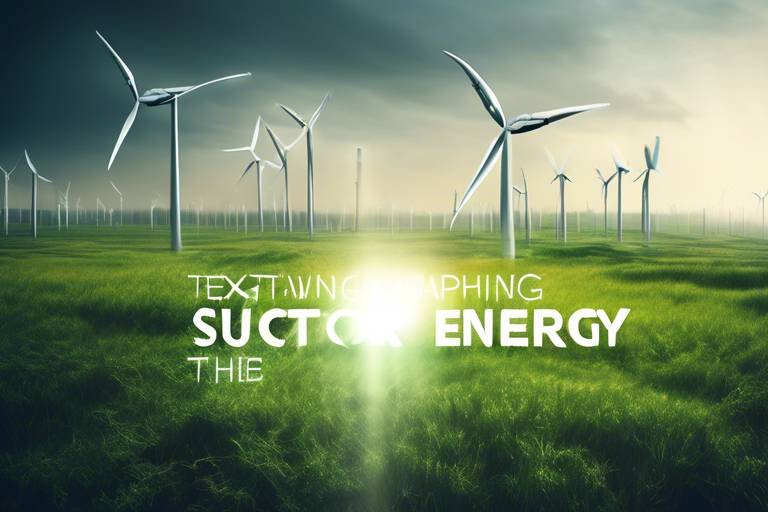Technologies Shaping the Future of the Sustainable Energy Sector
The landscape of energy production and consumption is undergoing a radical transformation, driven by innovative technologies that promise to reshape our approach to energy sustainability. As we confront the pressing challenges of climate change and resource depletion, the quest for sustainable energy solutions has never been more critical. The future of the energy sector hinges on a mix of renewable energy sources, energy storage solutions, and smart grid technologies, all working in tandem to create a more efficient, reliable, and environmentally friendly energy ecosystem.
Imagine a world where our energy needs are met without depleting our natural resources or polluting our planet. This vision is becoming increasingly achievable thanks to groundbreaking advancements in technology. From harnessing the power of the sun and wind to developing sophisticated energy storage systems that can hold vast amounts of electricity, the innovations emerging in the sustainable energy sector are not just exciting—they’re essential. These technologies are not merely tools; they represent a fundamental shift in how we think about energy generation, distribution, and consumption.
At the heart of this transformation are renewable energy sources such as solar, wind, and hydroelectric power. Each of these sources plays a pivotal role in reducing our reliance on fossil fuels and lowering greenhouse gas emissions. For instance, solar energy harnesses the sun's power through photovoltaic cells, while wind energy captures the kinetic energy of moving air. Hydro power, on the other hand, utilizes flowing water to generate electricity. Together, these sources contribute to a cleaner, more sustainable energy future that not only meets our current demands but also preserves resources for future generations.
However, the integration of these renewable sources into our energy grid comes with its own set of challenges, primarily due to their intermittent nature. This is where energy storage solutions become crucial. Technologies such as advanced batteries and pumped hydro storage systems are essential for managing the fluctuations in energy supply and demand. By storing excess energy generated during peak production times, we can ensure a steady supply even when renewable sources are not actively producing. This capability not only enhances the reliability of our energy systems but also reduces the need for backup fossil fuel power plants.
As we delve deeper into the innovations shaping this sector, we cannot overlook the role of smart grid technologies. These technologies are revolutionizing how electricity is distributed and consumed. By utilizing real-time data and advanced metering infrastructure, smart grids optimize energy distribution, enhance efficiency, and improve reliability. Imagine a system where your home’s energy usage adjusts automatically based on supply conditions—this is the promise of demand response systems, which encourage consumers to use energy during off-peak times, ultimately leading to cost savings and reduced strain on the grid.
Furthermore, the emergence of energy efficiency innovations across various sectors, including buildings and transportation, is vital for promoting sustainable energy use. Smart buildings equipped with automation technologies can significantly reduce energy consumption by optimizing heating, cooling, and lighting systems. In transportation, advancements in electric and hydrogen fuel cell vehicles are paving the way for a cleaner, more sustainable future, helping to drastically cut emissions from one of the largest contributors to air pollution.
As we look ahead, it’s clear that the future of sustainable energy is not just about technological advancements; it’s also about policy and regulatory frameworks that support these innovations. Government incentives for renewable energy projects and international agreements like the Paris Agreement are crucial in fostering an environment where sustainable practices can thrive. These frameworks encourage investment and innovation, ensuring that the transition to a sustainable energy future is not just a possibility but a reality.
In conclusion, the technologies shaping the future of the sustainable energy sector are as diverse as they are impactful. From renewable energy sources and energy storage solutions to smart grid technologies and energy efficiency innovations, each plays a vital role in creating a sustainable energy ecosystem. As we move forward, it is essential to embrace these innovations and support the policies that will enable their growth, ensuring a cleaner, greener future for generations to come.
- What are renewable energy sources? Renewable energy sources include solar, wind, hydro, geothermal, and biomass, all of which are naturally replenished and have a lower environmental impact compared to fossil fuels.
- Why is energy storage important? Energy storage is crucial for balancing supply and demand, particularly with intermittent renewable sources, ensuring a reliable and stable energy supply.
- How do smart grids work? Smart grids use technology to optimize the distribution of electricity, allowing for real-time monitoring and management of energy consumption and supply.
- What role do government policies play in sustainable energy? Government policies and incentives are vital for promoting investment in renewable energy technologies and supporting the transition to a sustainable energy future.

Renewable Energy Sources
When we think about the future of energy, immediately come to mind. These sources, which include solar, wind, and hydro power, are not just buzzwords; they represent a fundamental shift in how we generate and consume energy. Imagine harnessing the sun's rays or the wind's gentle breeze to power our homes and businesses. It’s like having nature as our ally in the quest for a cleaner, more sustainable future.
One of the most significant advantages of renewable energy is its environmental benefits. Unlike fossil fuels, which release harmful greenhouse gases into the atmosphere, renewable sources produce little to no emissions. This transition is essential for combating climate change and reducing our carbon footprint. For instance, solar panels can generate electricity without emitting a single gram of CO2, making them a game-changer for our planet.
Let’s delve into some of the key renewable energy sources:
- Solar Energy: Solar power harnesses sunlight using photovoltaic cells. With advancements in technology, solar panels have become more efficient and affordable, making them accessible to homeowners and businesses alike. Imagine your roof generating power while you enjoy a sunny day!
- Wind Energy: Wind turbines convert the kinetic energy of wind into electricity. As the wind blows, these towering structures spin and generate power. Wind farms are popping up in many regions, contributing significantly to the energy mix.
- Hydropower: Utilizing the flow of water, hydropower is one of the oldest forms of renewable energy. Dams and river systems can produce substantial amounts of electricity, providing a steady and reliable energy source.
These renewable sources not only contribute to a cleaner environment but also promote energy independence. By investing in local renewable energy, countries can reduce their reliance on imported fossil fuels, enhancing their energy security. This shift can create jobs, stimulate local economies, and foster innovation in energy technology.
Moreover, the cost of renewable energy has plummeted over the past decade. According to recent reports, the price of solar energy has fallen by more than 80%, making it one of the most cost-effective sources of electricity in many parts of the world. This dramatic decrease in cost is akin to finding a hidden treasure, allowing more people to tap into the benefits of clean energy.
As we continue to explore and invest in these renewable energy sources, we must also consider their integration into our existing energy systems. This involves not only the development of new technologies but also the adaptation of our infrastructure to accommodate these green giants. Transitioning to a sustainable energy future is not just a possibility; it's a necessity. The time to act is now, and the path is illuminated by the shining potential of renewable energy.
- What are renewable energy sources?
Renewable energy sources are energy sources that are replenished naturally and can be used repeatedly. Examples include solar, wind, and hydro energy. - Why are renewable energy sources important?
They are crucial for reducing greenhouse gas emissions, combating climate change, and providing sustainable energy solutions. - How do solar panels work?
Solar panels convert sunlight directly into electricity using photovoltaic cells. - What is the future of renewable energy?
The future looks promising, with ongoing advancements in technology, decreasing costs, and increasing adoption worldwide.

Energy Storage Solutions
As we dive into the world of sustainable energy, one of the most critical aspects to consider is . These technologies are essential for harnessing the power of renewable sources like solar and wind, which can be intermittent by nature. Imagine trying to fill a bathtub with a garden hose while the faucet is running; without a way to store that water, you’re going to have a lot of wasted potential. In the energy sector, storage acts as that bathtub, allowing us to capture and utilize energy when it’s available, rather than letting it slip away.
There are several innovative energy storage technologies that are revolutionizing the way we manage power. Among these, batteries and pumped hydro storage stand out as key players. Each has its own set of benefits and challenges, but together, they form a robust framework for enhancing our energy systems. Let’s take a closer look at these solutions.
When we think about energy storage, batteries are often the first thing that comes to mind. The latest advancements in battery technologies are nothing short of revolutionary. Lithium-ion batteries, which power everything from smartphones to electric vehicles, have seen significant improvements in energy density and lifespan. But the real game changer might be solid-state batteries. These batteries promise to deliver higher energy capacities, faster charging times, and enhanced safety compared to their liquid counterparts. The impact on both consumer electronics and electric vehicles could be profound, potentially leading to longer ranges and reduced charging times.
Grid-scale storage is another vital component of our energy future. As we integrate more renewable energy sources into the grid, the need for reliable storage solutions becomes increasingly important. Grid-scale batteries can store excess energy generated during peak production times and release it during periods of high demand. This not only stabilizes the energy supply but also allows for a more significant incorporation of renewables into the energy mix. Imagine a giant battery bank that can power entire cities when the sun isn't shining or the wind isn't blowing; that’s the potential of grid-scale storage.
On a smaller scale, home energy storage systems are empowering consumers to take control of their energy consumption. With the rise of solar panel installations, homeowners can now store excess energy generated during the day and use it during the evening when demand is higher. This not only reduces reliance on the grid but also helps in lowering electricity bills. Systems like the Tesla Powerwall exemplify this trend, allowing individuals to become more energy independent while contributing to a more sustainable future.
Now, let’s not overlook pumped hydro storage, a time-tested method that has been around for decades. This technology works by using excess energy to pump water uphill to a reservoir. When energy is needed, the water is released to flow back down through turbines, generating electricity. It’s like having a giant water battery! While it has its advantages, such as scalability and long-term storage capacity, there are challenges too, including environmental impacts and geographical limitations. Nonetheless, it remains a cornerstone of energy storage strategies worldwide.
- What are the main types of energy storage solutions? The main types include batteries (like lithium-ion and solid-state), pumped hydro storage, and thermal storage.
- How do batteries improve energy storage? Batteries store electrical energy chemically, allowing for fast discharge and recharge cycles, making them ideal for both grid and home applications.
- What role does pumped hydro storage play? Pumped hydro storage helps balance supply and demand by storing excess energy as potential energy in water, which can be converted back to electricity when needed.

Battery Technologies
When we talk about the future of energy storage, batteries are at the forefront of innovation. They are the unsung heroes that allow us to harness the power of renewable energy sources like solar and wind, which can be unpredictable. Imagine trying to fill a bathtub with a garden hose; without a proper drain, the water just spills over. Similarly, without effective battery technologies, we can’t store the excess energy generated on sunny or windy days for use when the sun isn’t shining or the wind isn’t blowing. This is where advancements in battery technologies come into play, ensuring that we can capture and utilize energy efficiently.
The most notable advancements have been in lithium-ion batteries and the emerging field of solid-state batteries. Lithium-ion batteries, which power everything from our smartphones to electric vehicles, have undergone significant improvements in terms of energy density, lifespan, and safety. With a higher energy density, these batteries can store more energy in a smaller space, making them ideal for electric vehicles (EVs) and portable electronics. On the other hand, solid-state batteries represent a revolutionary leap forward; they use a solid electrolyte instead of a liquid one, which can lead to increased safety and greater energy capacity.
But why should we care about these advancements? Well, consider this: as the demand for electric vehicles continues to rise, the need for efficient and sustainable battery technologies becomes even more critical. According to recent studies, the global electric vehicle market is expected to grow exponentially in the coming years, which means that the battery technology supporting this growth must keep pace. Battery recycling is also becoming a hot topic, as we need to ensure that the materials used in these batteries are sustainably sourced and disposed of. The circular economy model, which emphasizes recycling and reusing materials, is gaining traction in the battery industry.
Now, let’s delve deeper into the specifics with the following table that highlights the key differences between lithium-ion and solid-state batteries:
| Feature | Lithium-Ion Batteries | Solid-State Batteries |
|---|---|---|
| Electrolyte Type | Liquid | Solid |
| Energy Density | Moderate | High |
| Safety | Risk of overheating | Lower risk of fire |
| Manufacturing Cost | Lower | Higher |
| Lifecycle | Shorter | Longer |
As we move towards a more sustainable future, it’s crucial to understand that the evolution of battery technologies is not just about improving performance; it’s about creating a robust ecosystem that supports renewable energy integration. The convergence of battery technologies with smart grid systems means that we can optimize energy usage and distribution in real-time, making our energy systems more resilient and efficient.
In conclusion, the advancements in battery technologies are reshaping how we think about energy storage and consumption. As these technologies continue to evolve, they hold the promise of a more sustainable and efficient energy future. So, the next time you charge your phone or power your electric vehicle, take a moment to appreciate the complex technology behind those batteries—it's a game-changer for our planet!
- What is the main advantage of solid-state batteries over lithium-ion batteries? Solid-state batteries offer higher energy density and increased safety due to their solid electrolyte, reducing the risk of overheating and fire.
- How long do lithium-ion batteries typically last? On average, lithium-ion batteries can last between 2 to 10 years, depending on usage and charging habits.
- Are there any recycling programs for batteries? Yes, many companies and local governments have established battery recycling programs to recover valuable materials and reduce environmental impact.

Grid-Scale Storage
Grid-scale storage is becoming a pivotal player in the sustainable energy landscape, acting as a bridge between energy generation and consumption. As renewable energy sources like solar and wind are inherently intermittent, the need for reliable energy storage solutions is more crucial than ever. Grid-scale storage systems help to stabilize the energy supply by storing excess energy generated during peak production times and releasing it during periods of high demand. This not only enhances the reliability of the energy grid but also maximizes the utilization of renewable resources, reducing reliance on fossil fuels.
One of the most significant advantages of grid-scale storage is its ability to improve the overall efficiency of the energy system. By integrating these storage solutions, energy providers can better manage fluctuations in supply and demand, which ultimately leads to cost savings for consumers. For instance, during sunny or windy days, when renewable energy production is high, excess energy can be stored for later use. This process can reduce the need for peaker plants, which are typically more expensive to operate and contribute to higher emissions.
There are several technologies currently being utilized for grid-scale storage, each with its unique benefits and challenges. Here are a few notable ones:
- Pumped Hydro Storage: This is the most widely used form of grid-scale storage, which involves pumping water uphill to a reservoir during low demand and releasing it to generate electricity during high demand.
- Battery Storage: Lithium-ion and other advanced battery technologies are increasingly being deployed for grid-scale applications, offering rapid response times and flexibility in energy dispatch.
- Compressed Air Energy Storage (CAES): This method stores energy by compressing air in underground caverns, which can later be released to drive turbines and generate electricity.
Despite its advantages, grid-scale storage does face some challenges. The initial investment required for infrastructure development can be substantial, and the technology must be tailored to fit local energy needs and resources. Additionally, regulatory frameworks and market structures need to evolve to facilitate the integration of these storage systems into the existing grid. As we move towards a more sustainable energy future, addressing these challenges will be crucial for maximizing the benefits of grid-scale storage.
In conclusion, grid-scale storage is not just a supplement to renewable energy; it is a fundamental component of a resilient and efficient energy system. By investing in and advancing these technologies, we can ensure a more sustainable and reliable energy future for all.
Q1: What is grid-scale storage?
A1: Grid-scale storage refers to large-scale energy storage systems that help balance supply and demand on the energy grid, storing excess energy generated during low demand and releasing it during high demand.
Q2: What are the main types of grid-scale storage technologies?
A2: The main types include pumped hydro storage, battery storage (like lithium-ion), and compressed air energy storage (CAES).
Q3: Why is grid-scale storage important for renewable energy?
A3: It stabilizes the energy supply, maximizes the use of renewable resources, and reduces reliance on fossil fuels, making the energy system more efficient and sustainable.
Q4: What challenges does grid-scale storage face?
A4: Challenges include high initial investment costs, the need for regulatory changes, and the requirement for technology to be tailored to local energy needs.

Home Energy Storage
As we dive into the world of , it's essential to understand how these systems are revolutionizing the way we consume and manage energy in our homes. Imagine being able to harness sunlight during the day and store it for use during the night or on cloudy days. This isn't just a dream; it's a reality thanks to advancements in battery technology and energy management systems.
Home energy storage systems, primarily based on lithium-ion batteries, allow homeowners to store excess energy generated from renewable sources, such as solar panels. This energy can then be used during peak hours when electricity prices are higher, or during outages when traditional power sources fail. It's like having your own personal power plant right in your basement!
One of the most significant benefits of home energy storage is the ability to reduce reliance on the grid. By generating and storing your own energy, you can significantly lower your electricity bills and even contribute surplus energy back to the grid, earning credits in the process. This not only promotes a more sustainable lifestyle but also fosters a sense of energy independence.
However, it’s not all sunshine and rainbows. While the initial investment in home energy storage systems can be substantial, many homeowners find that the long-term savings on energy bills and the potential increase in property value make it worthwhile. Additionally, various government incentives and rebates can help offset these costs, making it more accessible for the average consumer.
When considering a home energy storage system, it's crucial to evaluate factors such as capacity, efficiency, and compatibility with existing solar systems. Here’s a quick overview of what to consider:
| Factor | Description |
|---|---|
| Capacity | The amount of energy the system can store, usually measured in kilowatt-hours (kWh). |
| Efficiency | How much of the stored energy can be used effectively, usually expressed as a percentage. |
| Compatibility | Whether the storage system can integrate with existing solar panels or other renewable energy sources. |
In summary, home energy storage systems are paving the way for a more sustainable and self-sufficient future. By enabling homeowners to capture and store renewable energy, these systems not only help in reducing energy costs but also contribute to a greener planet. As technology continues to evolve, we can expect even more innovative solutions that make energy storage more efficient, affordable, and accessible for everyone.
- What is home energy storage? Home energy storage refers to systems that store energy generated from renewable sources, allowing homeowners to use it later, especially during peak hours or outages.
- How do home energy storage systems work? They typically use batteries to store excess energy produced by solar panels or other renewable sources and release it when needed.
- Are there incentives for installing home energy storage? Yes, many governments offer incentives and rebates to encourage homeowners to invest in energy storage solutions.
- Can I install a home energy storage system without solar panels? Yes, you can install these systems independently, but their effectiveness is maximized when paired with renewable energy sources.

Pumped Hydro Storage
Pumped hydro storage (PHS) is a time-honored technology that has been pivotal in the energy sector for decades. It operates on a simple yet effective principle: water is pumped from a lower reservoir to an upper reservoir during periods of low energy demand or excess energy generation. When energy is needed, the stored water is released back down through turbines, generating electricity. This method not only provides a reliable way to store energy but also plays a critical role in balancing the grid, especially as renewable energy sources like wind and solar become more prevalent.
One of the primary advantages of pumped hydro storage is its ability to store large amounts of energy for extended periods. Unlike batteries, which have limited storage capacity, pumped hydro systems can store energy on a much larger scale, making them ideal for stabilizing the grid. According to recent studies, pumped hydro accounts for over 90% of the world's energy storage capacity, highlighting its significance in the transition to a sustainable energy future.
However, the implementation of pumped hydro storage is not without challenges. The construction of new facilities requires considerable investment and suitable geographical locations, which can limit their deployment. Additionally, environmental concerns regarding the alteration of landscapes and ecosystems must be taken into account. Balancing these factors is crucial for the sustainable development of pumped hydro systems.
Despite these challenges, the potential for pumped hydro storage remains vast. As we look towards the future, innovations in technology and design may help to overcome some of the limitations currently faced. For instance, the development of closed-loop systems, which do not require a natural water source, could open up new possibilities for energy storage in areas where water resources are scarce.
In summary, pumped hydro storage is a cornerstone of energy storage solutions, offering a reliable and efficient method for balancing energy supply and demand. As the world continues to shift towards renewable energy, the role of PHS will likely become even more critical, ensuring that we can harness the full potential of sustainable energy sources.
- What is pumped hydro storage?
Pumped hydro storage is a method of storing energy by moving water between two reservoirs at different elevations, generating electricity when needed. - How does pumped hydro storage work?
During low energy demand, excess electricity is used to pump water to an upper reservoir. When energy is needed, the water is released back down to generate electricity. - What are the advantages of pumped hydro storage?
Pumped hydro storage can store large amounts of energy, helps stabilize the grid, and is one of the most established forms of energy storage. - What challenges does pumped hydro storage face?
Challenges include high initial costs, the need for suitable geographical locations, and potential environmental impacts.

Smart Grid Technologies
As we stand on the brink of a new energy era, are leading the charge towards a more efficient and reliable energy system. Imagine a power grid that not only delivers electricity but also communicates with consumers and devices to optimize energy use. This is the essence of smart grid technology. It integrates advanced communication systems, automated controls, and data analytics to create a responsive and adaptable energy network.
One of the most compelling aspects of smart grids is their ability to enhance energy distribution and consumption. By utilizing real-time data, these technologies can identify energy demand patterns and adjust supply accordingly. This means less waste, lower costs, and a significant reduction in greenhouse gas emissions. For instance, during peak hours, smart grids can shift energy usage to off-peak times, effectively flattening the demand curve and maximizing efficiency.
Moreover, smart grid technologies empower consumers by providing them with detailed insights into their energy consumption. With advanced metering infrastructure (AMI), users can monitor their usage in real-time. This transparency encourages energy-saving behaviors and allows consumers to make informed decisions about their energy consumption. Imagine having the power to see how much energy your appliances use at any given moment. This level of awareness can lead to substantial savings on energy bills.
Another critical component of smart grid technologies is demand response systems. These systems play a pivotal role in balancing supply and demand by incentivizing consumers to reduce or shift their electricity usage during peak periods. For example, during a hot summer day when air conditioning use spikes, demand response programs can offer financial incentives for consumers to lower their usage, thus preventing blackouts and maintaining grid stability.
Additionally, the integration of renewable energy sources into the grid is made more feasible with smart grid technologies. As we increasingly turn to solar and wind energy, managing these intermittent resources becomes crucial. Smart grids facilitate the smooth integration of renewables by using sophisticated forecasting tools and energy storage solutions. This not only enhances the reliability of renewable energy but also provides a cleaner, more sustainable energy mix.
To illustrate the impact of smart grid technologies, consider the following table that outlines the key benefits:
| Benefit | Description |
|---|---|
| Improved Reliability | Reduces outages and enhances response times during disruptions. |
| Cost Savings | Lower energy bills through efficient energy use and demand response. |
| Environmental Impact | Facilitates the integration of renewable energy sources, reducing carbon footprint. |
| Consumer Empowerment | Provides real-time data and insights, enabling informed energy decisions. |
In conclusion, smart grid technologies are not just a futuristic concept; they are the backbone of a sustainable energy future. By optimizing energy distribution and empowering consumers, these technologies pave the way for a more resilient, efficient, and environmentally friendly energy landscape. As we continue to innovate and adopt these systems, the potential for a cleaner planet becomes increasingly within reach.
- What are smart grids? Smart grids are advanced electrical grids that use technology to improve the reliability, efficiency, and sustainability of electricity distribution.
- How do smart grids benefit consumers? They provide real-time data on energy usage, enable cost savings through demand response programs, and facilitate the integration of renewable energy sources.
- Are smart grids safe? Yes, smart grids incorporate advanced security measures to protect against cyber threats and ensure the integrity of the energy system.

Demand Response Systems
Demand response systems are revolutionizing how we think about energy consumption and distribution. Imagine a world where your energy usage is not just a static number but a dynamic part of a larger ecosystem that balances supply and demand in real-time. These systems allow utilities to communicate with consumers, encouraging them to adjust their energy usage during peak periods or when renewable energy generation is low. By shifting or reducing their consumption, users can help stabilize the grid, reduce energy costs, and even earn incentives. It’s like being part of a team where every member plays a crucial role in achieving a common goal: a more efficient and sustainable energy future.
One of the most compelling aspects of demand response systems is their ability to integrate seamlessly with smart technologies. For instance, smart thermostats can automatically adjust heating or cooling in response to price signals from the utility. This not only saves money for consumers but also helps avoid blackouts and reduces the need for costly peaker plants that often rely on fossil fuels. The benefits are twofold: consumers enjoy lower bills, and the environment gets a breather.
Moreover, demand response systems can be categorized into two main types: price-based and incentive-based programs. Price-based programs encourage consumers to reduce their usage when prices spike, while incentive-based programs provide financial rewards for participation. This flexibility allows consumers to choose how they engage with the system, making it easier for everyone to contribute to energy efficiency.
But how effective are these systems in practice? A recent study showed that demand response programs could reduce peak demand by as much as 10-15%. This reduction is significant, considering that peak demand often drives the need for additional energy sources, which can be expensive and environmentally damaging. By leveraging demand response, we can optimize existing resources and minimize waste.
As we move towards a more interconnected and sustainable energy grid, the role of demand response systems will only grow. They are not just a temporary fix; they are part of a broader strategy to create a resilient energy ecosystem. By empowering consumers and integrating advanced technologies, these systems pave the way for a future where energy is used more wisely and efficiently.
- What is a demand response system? A demand response system is a strategy used by utilities to manage consumer energy usage during peak demand times, encouraging users to reduce or shift their energy consumption.
- How can I participate in demand response programs? Consumers can participate by enrolling in programs offered by their utility, which may include incentives for reducing usage during peak times or using smart devices to automate adjustments.
- What are the benefits of demand response? Benefits include lower energy costs, reduced strain on the grid, and a positive environmental impact by decreasing the need for fossil fuel-based energy sources.

Advanced Metering Infrastructure
Advanced Metering Infrastructure (AMI) is revolutionizing the way we manage and consume energy. Imagine a world where your energy usage is monitored in real-time, allowing you to make informed decisions about your consumption patterns. This cutting-edge technology integrates smart meters, communication networks, and data management systems, creating a seamless flow of information between utilities and consumers. The result? Enhanced efficiency, reduced costs, and a significant leap towards sustainable energy practices.
At the heart of AMI are smart meters, which are not just your ordinary energy meters. They collect detailed data on energy consumption at frequent intervals, often every 15 minutes or even more frequently. This data is then transmitted back to the utility in real-time, enabling them to monitor usage trends and identify issues promptly. For consumers, this means greater visibility into their energy habits, empowering them to adjust their usage and save money. It's like having a personal energy coach right in your home!
One of the most significant advantages of AMI is its ability to facilitate demand response programs. These programs allow utilities to manage energy loads more effectively by encouraging consumers to shift their energy usage during peak demand times. For instance, during a hot summer afternoon when air conditioning use spikes, utilities can send signals to smart meters, prompting consumers to reduce their usage temporarily. This not only helps in stabilizing the grid but also allows consumers to benefit from lower rates during off-peak times.
Moreover, the implementation of AMI can lead to significant operational efficiencies for utilities. With real-time data, utilities can reduce the need for manual meter readings, cut down on operational costs, and improve their response times to outages. This enhanced reliability and efficiency can lead to a more sustainable energy system overall. For example, utilities can quickly pinpoint areas experiencing outages, minimizing downtime and improving customer satisfaction.
However, the transition to AMI is not without its challenges. Privacy concerns regarding data collection and security issues related to the transmission of sensitive information are paramount. Consumers are rightfully cautious about how their energy usage data is used and who has access to it. Therefore, it is crucial for utilities to implement robust security measures and maintain transparency with consumers about how their data is being utilized.
In summary, Advanced Metering Infrastructure is a game-changer in the energy sector. It not only enhances operational efficiency for utilities but also empowers consumers to take control of their energy usage. As we continue to innovate and integrate these technologies, the potential for a more sustainable and efficient energy future becomes increasingly attainable. The journey towards smarter energy consumption is just beginning, and AMI is at the forefront of this transformation.
- What is Advanced Metering Infrastructure?
Advanced Metering Infrastructure (AMI) refers to an integrated system of smart meters, communication networks, and data management systems that facilitate real-time monitoring and management of energy consumption. - How does AMI benefit consumers?
AMI provides consumers with detailed insights into their energy usage, enabling them to make informed decisions that can lead to cost savings and more efficient energy consumption. - What are the security concerns associated with AMI?
Concerns include the privacy of consumer data and the potential for unauthorized access to sensitive information. Utilities must implement strong security measures to protect this data. - Can AMI help reduce energy costs?
Yes, by participating in demand response programs and shifting energy usage to off-peak times, consumers can benefit from lower energy rates.

Energy Efficiency Innovations
In the quest for a sustainable energy future, are taking center stage. Imagine a world where we can do more with less—less energy, fewer emissions, and reduced costs. This is not just a dream; it's becoming a reality through groundbreaking technologies and strategies across various sectors. From smart buildings that adapt to our needs to electric vehicles that redefine transportation, the innovations in energy efficiency are transforming how we consume energy.
One of the most exciting developments is the rise of smart buildings. These structures utilize advanced technology to monitor and optimize energy usage, leading to significant reductions in waste. For instance, smart thermostats can learn a building's occupancy patterns and adjust heating and cooling accordingly. This not only enhances comfort but can also lead to energy savings of up to 30%. Furthermore, integrating renewable energy sources, such as solar panels, into building designs can create self-sustaining energy systems, dramatically lowering reliance on traditional power grids.
In the transportation sector, efficient transportation solutions are gaining traction. Electric vehicles (EVs) and hydrogen fuel cell vehicles are at the forefront of this revolution. EVs, powered by clean energy, can significantly cut down greenhouse gas emissions compared to their gasoline counterparts. Additionally, advancements in battery technology are making EVs more accessible and practical for everyday use. For example, the development of fast-charging stations is reducing downtime for drivers, making electric vehicles a more viable option for long trips.
Moreover, the concept of vehicle-to-grid (V2G) technology is emerging, allowing electric vehicles to not only draw power from the grid but also return it when demand peaks. This two-way interaction helps stabilize the grid and enhances energy efficiency across the board. Imagine your car not just being a mode of transport but also a vital part of the energy ecosystem!
In industrial processes, energy efficiency innovations are equally impressive. Companies are increasingly adopting energy management systems (EMS) that provide real-time data on energy consumption. This data empowers businesses to identify inefficiencies and implement targeted improvements. For example, a manufacturing plant might find that changing the timing of machinery operation can lead to substantial energy savings. By optimizing operations, businesses can reduce costs and contribute to sustainability goals.
To put it all in perspective, consider the following table that highlights some key energy efficiency innovations and their potential impacts:
| Innovation | Sector | Potential Impact |
|---|---|---|
| Smart Thermostats | Buildings | Up to 30% energy savings |
| Electric Vehicles | Transportation | Significant reduction in emissions |
| Energy Management Systems | Industry | Cost reductions through operational efficiencies |
In conclusion, the innovations in energy efficiency are not just about saving energy; they are about creating a sustainable future where energy is used wisely and responsibly. As these technologies continue to evolve, they will play a crucial role in reducing our carbon footprint and ensuring a healthier planet for future generations.
- What are energy efficiency innovations? - These are technologies and strategies designed to reduce energy consumption while maintaining the same level of service or output.
- How do smart buildings improve energy efficiency? - Smart buildings utilize advanced technologies to monitor and optimize energy usage, leading to significant reductions in waste.
- What role do electric vehicles play in energy efficiency? - Electric vehicles reduce greenhouse gas emissions and, with technologies like vehicle-to-grid, enhance energy management across the grid.
- Why is energy management important in industries? - Energy management systems provide real-time data that help businesses identify inefficiencies and implement improvements, leading to cost savings and sustainability.

Smart Buildings
In today's fast-paced world, the concept of is revolutionizing the way we think about energy consumption and efficiency. Imagine living or working in a space that not only anticipates your needs but also optimizes energy use without you lifting a finger. Smart buildings leverage advanced technologies to create environments that are not only comfortable but also environmentally friendly. By integrating systems such as heating, ventilation, air conditioning (HVAC), lighting, and security, these buildings can significantly reduce energy waste and lower operational costs.
One of the key features of smart buildings is their ability to monitor and analyze energy consumption in real-time. This is achieved through a combination of Internet of Things (IoT) devices and sophisticated software platforms that gather data from various sensors placed throughout the building. For instance, sensors can detect occupancy levels and adjust lighting and temperature accordingly, ensuring that energy is used only when needed. This responsive approach not only enhances comfort but also leads to substantial energy savings.
Moreover, smart buildings often incorporate renewable energy sources, such as solar panels, to further enhance sustainability. By generating their own energy, these buildings can reduce their reliance on the grid, leading to lower energy bills and a smaller carbon footprint. The integration of energy storage solutions, like batteries, allows these buildings to store excess energy generated during the day for use during peak hours, maximizing efficiency.
Another exciting aspect of smart buildings is the use of automation and artificial intelligence. Imagine a building that learns your preferences over time, adjusting lighting and temperature based on your habits. This level of personalization not only improves occupant satisfaction but also optimizes energy usage. For example, during peak electricity hours, the building can automatically shift non-essential loads to off-peak times, minimizing costs and strain on the grid.
But the benefits of smart buildings extend beyond just energy savings. They also contribute to improved health and well-being. Enhanced air quality systems monitor pollutants and adjust ventilation to ensure a healthier indoor environment. Natural lighting systems can be programmed to mimic daylight patterns, boosting productivity and mood. In essence, smart buildings create a holistic environment that nurtures both people and the planet.
As we look to the future, the trend towards smart buildings is expected to grow. With advancements in technology and increasing awareness of sustainability, more developers are investing in smart building solutions. However, it’s essential to consider the initial costs associated with implementing these technologies. While the upfront investment can be significant, the long-term savings and benefits often outweigh these costs.
In conclusion, smart buildings represent a significant leap towards a more sustainable and efficient future. By harnessing the power of technology, they not only reduce energy consumption but also enhance the quality of life for their occupants. As we continue to innovate and adapt, the potential for smart buildings to transform our urban landscapes is limitless.
- What are smart buildings? Smart buildings use advanced technologies to optimize energy use, enhance comfort, and improve overall efficiency.
- How do smart buildings save energy? They utilize sensors and automation to monitor and adjust energy consumption based on real-time data.
- Are smart buildings more expensive to build? While initial costs can be higher, the long-term savings and benefits often justify the investment.
- What technologies are used in smart buildings? Common technologies include IoT devices, energy management systems, and automation software.

Efficient Transportation Solutions
The transportation sector is undergoing a remarkable transformation, driven by the urgent need for sustainability and efficiency. As cities grow and the demand for mobility increases, have become more critical than ever. Imagine a world where our vehicles not only get us from point A to point B but also do so with minimal environmental impact. This vision is becoming a reality through advancements in electric vehicles (EVs) and hydrogen fuel cell technology.
Electric vehicles are at the forefront of this transformation. They offer a cleaner alternative to traditional gasoline-powered cars, significantly reducing greenhouse gas emissions. The beauty of EVs lies not just in their zero tailpipe emissions but also in their efficiency. For instance, electric motors convert over 60% of the electrical energy from the grid to power at the wheels, compared to conventional gasoline vehicles that only convert about 20% of the energy stored in gasoline. This impressive efficiency means that EVs can travel further on less energy, which is a win-win for both consumers and the environment.
In addition to electric vehicles, hydrogen fuel cell technology is also making waves. Hydrogen fuel cells generate electricity through a chemical reaction between hydrogen and oxygen, producing only water vapor as a byproduct. This technology is particularly promising for heavy-duty transportation, such as trucks and buses, where battery weight can be a concern. With hydrogen fuel cells, vehicles can refuel quickly and travel long distances without the heavy battery packs that electric vehicles require. This efficiency opens up new possibilities for sustainable logistics and public transport systems.
Moreover, the integration of autonomous driving technology with electric and hydrogen vehicles is set to revolutionize transportation even further. Imagine a fleet of self-driving electric taxis zipping around your city, optimizing routes in real-time to reduce congestion and emissions. This scenario is not far off, as companies invest heavily in research and development to bring these technologies to market.
To better illustrate the impact of these innovations, consider the following table that compares the efficiency of traditional vehicles, electric vehicles, and hydrogen fuel cell vehicles:
| Vehicle Type | Energy Conversion Efficiency | Emissions | Refueling Time |
|---|---|---|---|
| Traditional Gasoline Vehicle | 20% | High | 5-10 minutes |
| Electric Vehicle | 60%+ | Zero | 30 minutes to several hours (depending on charger) |
| Hydrogen Fuel Cell Vehicle | 50-60% | Zero | 3-5 minutes |
As we embrace these efficient transportation solutions, it's essential to consider their broader implications. The shift towards electric and hydrogen vehicles could significantly reduce our reliance on fossil fuels, lower air pollution levels, and contribute to a more sustainable urban environment. However, this transition requires robust infrastructure, such as charging stations and hydrogen refueling facilities, to support widespread adoption.
In summary, the future of transportation is not just about getting from one place to another; it's about how we do it. With electric and hydrogen technologies paving the way for a cleaner, more efficient transportation system, we can look forward to a future where our journeys leave a minimal footprint on the planet. The road ahead is exciting, and as we continue to innovate, the possibilities are endless.
- What are electric vehicles? Electric vehicles (EVs) are cars that run on electricity instead of gasoline, providing a cleaner alternative with lower emissions.
- How do hydrogen fuel cells work? Hydrogen fuel cells generate electricity by combining hydrogen and oxygen, producing only water vapor as a byproduct.
- What are the benefits of using efficient transportation solutions? These solutions reduce greenhouse gas emissions, lower energy consumption, and promote sustainable urban mobility.
- Are electric vehicles more expensive than traditional vehicles? While the initial cost may be higher, the long-term savings on fuel and maintenance can make EVs more economical over time.

Carbon Capture Technologies
As we grapple with the pressing issue of climate change, have emerged as a beacon of hope in the quest to reduce greenhouse gas emissions. These innovative solutions are designed to capture carbon dioxide (CO2) emissions from various sources, including power plants and industrial facilities, preventing this harmful gas from entering the atmosphere. By doing so, they play a crucial role in mitigating climate change and promoting a more sustainable future.
One of the most significant advancements in this field is carbon capture and storage (CCS), which involves capturing CO2 emissions and securely storing them underground in geological formations. This technology not only helps in reducing the carbon footprint of existing industries but also allows for the continued use of fossil fuels in a more environmentally friendly manner. The potential for CCS is vast, but it also comes with challenges, such as the need for extensive infrastructure and regulatory frameworks to ensure safety and efficiency.
Another exciting development is direct air capture (DAC). Unlike traditional CCS, which captures emissions at the source, DAC technology extracts CO2 directly from the atmosphere. This innovative approach has the potential to actively reduce the concentration of CO2 in the air, making it a powerful tool in the fight against climate change. The mechanisms behind DAC involve chemical processes that bind CO2, which is then either stored or utilized in various applications.
Speaking of utilization, the captured carbon can be transformed into valuable products, which is an exciting aspect of carbon capture technologies. For instance, captured CO2 can be converted into fuels, such as synthetic gasoline or methanol, or even into materials like plastics. This not only helps in closing the carbon loop but also creates a circular economy where waste becomes a resource. The potential applications are vast, and ongoing research continues to uncover new ways to utilize captured carbon effectively.
To better understand the impact of carbon capture technologies, it’s essential to consider some key statistics:
| Technology | CO2 Capture Potential (Million Tonnes per Year) | Current Status |
|---|---|---|
| Carbon Capture and Storage (CCS) | 2,000+ | Operational Projects |
| Direct Air Capture (DAC) | 1,000+ | Pilot Projects |
| Utilization of Captured Carbon | 500+ | Emerging Technologies |
While the promise of carbon capture technologies is significant, it’s crucial to acknowledge the challenges ahead. Issues such as high costs, energy requirements, and the need for widespread adoption pose hurdles that must be overcome. However, with increasing investment and interest from both the public and private sectors, there is a growing optimism that these technologies can play a pivotal role in achieving global climate goals.
- What is carbon capture technology?
Carbon capture technology refers to processes that capture carbon dioxide emissions from sources like power plants and industrial facilities to prevent them from entering the atmosphere. - How does direct air capture work?
Direct air capture utilizes chemical processes to bind CO2 from the atmosphere, which is then stored or transformed into useful products. - What are the benefits of utilizing captured carbon?
Utilizing captured carbon can help create valuable products, such as fuels and materials, contributing to a circular economy and reducing overall emissions.

Direct Air Capture
Direct Air Capture (DAC) is an innovative technology that aims to address the pressing issue of climate change by actively removing carbon dioxide (CO2) from the atmosphere. Imagine a giant vacuum cleaner, but instead of cleaning your living room, it’s sucking up CO2 from the air around us. This process involves using chemical reactions to capture CO2 directly from the ambient air, which can then be stored or utilized in various ways. The potential of DAC lies not only in its ability to mitigate greenhouse gas emissions but also in its role in achieving net-zero targets set by countries and organizations worldwide.
The DAC process typically involves two main steps: capturing CO2 and then either storing it underground or converting it into useful products. This dual approach makes DAC a versatile solution in the fight against climate change. For instance, captured CO2 can be transformed into fuels, plastics, or even carbonated beverages. It’s like turning a problem into a resource! However, implementing DAC on a large scale presents several challenges, including energy consumption, cost-effectiveness, and the need for substantial infrastructure.
Let’s break down the components of Direct Air Capture:
- Capture Technology: Various methods are employed to capture CO2, including chemical sorbents and filters that trap CO2 molecules as air passes through them.
- Energy Requirements: DAC systems require energy, typically derived from renewable sources, to operate efficiently. The challenge is to ensure that this energy consumption does not offset the environmental benefits.
- Storage and Utilization: Once captured, CO2 can be compressed and stored underground in geological formations, or it can be utilized in industrial processes, contributing to a circular carbon economy.
Recent advancements in DAC technology have led to significant improvements in efficiency and cost. Companies like Climeworks and Carbon Engineering are at the forefront, developing systems that can capture thousands of tons of CO2 annually. These innovations are crucial as they pave the way for scalable solutions that can be deployed globally. Moreover, as public awareness of climate change grows, so does the interest in investing in technologies like DAC, which can play a pivotal role in achieving sustainability goals.
In the broader context of carbon management, DAC is often seen as a complementary solution alongside emission reductions. While reducing emissions from existing sources is vital, DAC provides a way to address historical emissions and contribute to a net-negative carbon future. It’s like cleaning up a mess while also preventing new messes from occurring.
As we look to the future, the integration of DAC with other technologies, such as renewable energy and energy storage, could lead to even more significant advancements in carbon management. This synergy could create a robust ecosystem for tackling climate change, where capturing carbon becomes a standard practice in various industries. The journey towards a sustainable future is undoubtedly challenging, but with innovative solutions like Direct Air Capture, there’s hope on the horizon.
- What is Direct Air Capture? Direct Air Capture is a technology that removes carbon dioxide from the atmosphere using chemical processes.
- How does DAC work? DAC systems capture CO2 from the air, which can then be stored or converted into useful products.
- What are the benefits of DAC? DAC helps mitigate climate change by reducing atmospheric CO2 levels and can turn captured carbon into valuable resources.
- Are there any challenges with DAC? Yes, challenges include high energy consumption, costs, and the need for infrastructure to support large-scale implementation.

Utilization of Captured Carbon
The utilization of captured carbon is an innovative approach that not only addresses the pressing issue of greenhouse gas emissions but also opens up a realm of possibilities for creating valuable products. Imagine taking something harmful, like carbon dioxide (CO2), and transforming it into useful materials or fuels. This is not just a dream—it's happening right now! By capturing CO2 from industrial processes and power generation, we can significantly reduce the amount of greenhouse gases released into the atmosphere. But what happens next? Well, that's where the magic of carbon utilization comes into play.
One of the most exciting aspects of captured carbon utilization is its versatility. The captured CO2 can be converted into a variety of products, including:
- Fuels: CO2 can be converted into synthetic fuels, which can be used in transportation, thus reducing reliance on fossil fuels.
- Building Materials: Captured carbon can be used to produce cement and other construction materials, which helps to lower the carbon footprint of the construction industry.
- Chemicals: Various chemicals, including methanol and urea, can be synthesized from CO2, leading to more sustainable manufacturing processes.
These innovative uses not only help in reducing the carbon footprint but also contribute to a circular economy where waste is minimized, and resources are reused. For instance, the process of converting CO2 into fuels could potentially create a closed-loop system where the emissions from burning these fuels are captured again, further reducing net emissions.
However, while the potential is enormous, there are still challenges to overcome. The technology for capturing and utilizing carbon is advancing, but it requires significant investment and research to make it economically viable on a large scale. Additionally, the energy required for these conversion processes must come from renewable sources to ensure that the overall impact on climate change is positive.
As we look to the future, the utilization of captured carbon could play a pivotal role in our transition to a sustainable energy landscape. By turning a liability into an asset, we can not only combat climate change but also drive innovation across various industries. The synergy between carbon capture and utilization technologies could potentially reshape our approach to energy and resource management, making it a key component of a sustainable future.
- What is carbon capture and utilization? Carbon capture and utilization (CCU) refers to technologies that capture carbon dioxide emissions from sources like power plants and convert it into useful products.
- How does utilizing captured carbon help the environment? By converting CO2 into valuable products, we can reduce greenhouse gas emissions and promote a circular economy, thereby mitigating climate change.
- What types of products can be made from captured carbon? Captured carbon can be transformed into fuels, building materials, and various chemicals, contributing to sustainable manufacturing processes.
- Are there challenges associated with carbon utilization? Yes, while the technology is promising, it requires significant investment and research to become economically viable and must utilize renewable energy sources for a positive impact.

Policy and Regulatory Frameworks
The transition to a sustainable energy future is not just about innovative technologies; it also heavily relies on that can foster growth and encourage investment in renewable energy. Governments around the world are recognizing the urgency of climate change and are implementing a variety of policies designed to support the development and deployment of sustainable energy technologies. This includes everything from tax incentives to stricter emissions regulations, all aimed at creating a conducive environment for green energy initiatives.
One of the most effective tools in promoting renewable energy is the introduction of incentives. These can take several forms, such as subsidies, tax credits, or feed-in tariffs, which guarantee a fixed payment for energy produced from renewable sources. By reducing the financial burden on developers and consumers alike, these incentives encourage the adoption of technologies like solar and wind power. For instance, in the United States, the Investment Tax Credit (ITC) has significantly boosted solar energy installations by allowing homeowners and businesses to deduct a substantial percentage of the cost of installing a solar energy system from their federal taxes.
Moreover, international agreements play a crucial role in shaping global energy policies. Agreements like the Paris Agreement set binding commitments for countries to reduce greenhouse gas emissions, thus pushing nations to transition towards sustainable practices. These agreements not only foster collaboration among countries but also provide a framework for accountability. For example, under the Paris Agreement, countries are required to submit their long-term low-emission development strategies, which outline how they plan to achieve their climate goals.
However, while these policies are essential, they also pose challenges. The regulatory landscape can be complex and varies significantly from one country to another. This inconsistency can create uncertainty for investors and developers, potentially stalling progress in the renewable energy sector. A clear and consistent regulatory framework is vital for fostering innovation and ensuring that sustainable energy technologies can compete on equal footing with traditional fossil fuels.
To illustrate the impact of policy frameworks, consider the following table that summarizes some key incentives and regulations across different regions:
| Region | Incentive Type | Description |
|---|---|---|
| United States | Investment Tax Credit | Allows a percentage of the cost of solar installations to be deducted from federal taxes. |
| European Union | Feed-in Tariffs | Guarantees fixed payments for energy produced from renewable sources for a set period. |
| China | Renewable Energy Portfolio Standards | Mandates that a certain percentage of energy must come from renewable sources. |
As we move forward, it’s clear that a robust policy framework is essential for the growth of the sustainable energy sector. By aligning economic incentives with environmental goals, countries can not only achieve their climate targets but also stimulate economic growth and job creation in the green energy sector. The challenge lies in ensuring that these policies are adaptable and resilient to the fast-paced changes in technology and market dynamics.
- What are the main types of policies that support renewable energy? Governments typically implement incentives such as tax credits, feed-in tariffs, and renewable energy portfolio standards to encourage investment in renewable sources.
- How do international agreements impact national energy policies? International agreements like the Paris Agreement set targets for emissions reductions, prompting countries to develop their own policies that align with these global goals.
- What challenges do regulatory frameworks pose for renewable energy? Inconsistencies in regulations across different regions can create uncertainty for investors, making it difficult for renewable energy projects to secure funding and support.

Incentives for Renewable Energy
When it comes to driving the transition towards a sustainable energy future, play a pivotal role. Governments around the world recognize the importance of reducing greenhouse gas emissions and promoting clean energy sources, and they have implemented various programs to encourage investment in renewable technologies. These incentives can take many forms, including tax credits, grants, and subsidies, all designed to make renewable energy projects more financially viable.
One of the most significant incentives is the Investment Tax Credit (ITC), which allows individuals and businesses to deduct a percentage of the cost of installing solar energy systems from their federal taxes. This credit has been a game-changer for the solar industry, making solar installations more affordable for homeowners and businesses alike. Similarly, the Production Tax Credit (PTC) provides financial incentives for wind energy projects based on the amount of electricity generated, further spurring growth in this sector.
In addition to federal incentives, many states offer their own programs to promote renewable energy. For example, Renewable Portfolio Standards (RPS) require utilities to obtain a certain percentage of their energy from renewable sources. This creates a market demand for renewable energy and encourages investment in new projects. Furthermore, some states provide performance-based incentives, which reward energy producers for their actual output, ensuring that only efficient and productive systems benefit.
Moreover, the rise of community solar projects has opened doors for individuals who may not have the means to install solar panels on their properties. These initiatives allow multiple participants to invest in a shared solar array, receiving credits on their utility bills for the energy produced. This democratization of renewable energy access is crucial for broadening participation in the clean energy transition.
To illustrate the impact of these incentives, consider the following table that outlines some key federal and state-level incentives available for renewable energy projects:
| Incentive Type | Description | Applicable Technologies |
|---|---|---|
| Investment Tax Credit (ITC) | Tax credit for solar energy system installations. | Solar |
| Production Tax Credit (PTC) | Tax credit based on electricity generated from renewable sources. | Wind, Geothermal |
| Renewable Portfolio Standards (RPS) | State mandates for utilities to source a percentage of energy from renewables. | All Renewables |
| Performance-Based Incentives | Payments based on actual energy production. | Solar, Wind |
In conclusion, the incentives for renewable energy are crucial for fostering innovation and investment in this vital sector. By making renewable technologies more accessible and financially feasible, these programs not only benefit the environment but also create jobs and stimulate economic growth. As we move forward, it is essential to continue supporting and expanding these incentives to ensure a sustainable energy future for all.
- What are the main types of incentives for renewable energy? There are several types of incentives, including tax credits, grants, rebates, and renewable portfolio standards.
- How do the Investment Tax Credit and Production Tax Credit work? The ITC allows for a percentage of solar installation costs to be deducted from taxes, while the PTC provides credits based on the amount of energy produced from renewable sources.
- Are there incentives for community solar projects? Yes, many states offer incentives that make community solar projects financially attractive, allowing shared investment in solar arrays.

International Agreements
International agreements play a pivotal role in shaping the landscape of sustainable energy. These agreements are not just bureaucratic paperwork; they are the frameworks that guide nations toward a common goal: reducing greenhouse gas emissions and promoting sustainable practices. One of the most significant agreements in recent history is the Paris Agreement, adopted in 2015, which aims to limit global warming to well below 2 degrees Celsius above pre-industrial levels. This ambitious target has set the stage for countries to commit to reducing their carbon footprints and transitioning to renewable energy sources.
But how do these agreements actually work? They establish legally binding commitments for participating countries to set their own nationally determined contributions (NDCs) to emissions reductions. This flexibility allows nations to tailor their strategies according to their unique circumstances, yet it also fosters a sense of accountability. Countries are encouraged to report their progress regularly, which creates a transparent environment for monitoring and evaluation.
Moreover, international agreements often come with financial mechanisms to support developing nations in their transition to sustainable energy. For instance, the Green Climate Fund was established to assist these countries in implementing their climate action plans. This fund aims to mobilize $100 billion annually by 2020, although achieving this goal has proven challenging. Nevertheless, the promise of financial support is crucial for nations that might otherwise struggle to invest in renewable energy technologies.
Another key aspect of international agreements is the emphasis on technology transfer. Developed nations are encouraged to share their technological advancements with developing countries, which can significantly accelerate the global transition to sustainable energy. This collaboration fosters innovation and helps bridge the gap between countries with varying levels of resources and capabilities.
In addition to the Paris Agreement, there are other significant accords, such as the Kyoto Protocol and the Montreal Protocol. Each of these agreements has played a role in shaping policies around climate action and environmental sustainability. The Kyoto Protocol, for example, was the first major international agreement to set legally binding targets for developed countries to reduce their greenhouse gas emissions. Meanwhile, the Montreal Protocol successfully phased out substances that deplete the ozone layer, showcasing how international cooperation can yield positive environmental outcomes.
As we look to the future, the role of international agreements in sustainable energy will only become more critical. With the rise of global challenges such as climate change, energy security, and economic inequality, these agreements provide a platform for countries to collaborate and innovate. The key takeaway is that while individual nations may have their own agendas, international agreements help align these agendas toward a sustainable and equitable energy future.
- What is the Paris Agreement? The Paris Agreement is an international treaty that aims to limit global warming to well below 2 degrees Celsius, encouraging countries to reduce greenhouse gas emissions.
- How do international agreements support developing countries? They often include financial mechanisms, such as the Green Climate Fund, to help these nations implement sustainable energy projects.
- What is technology transfer in the context of international agreements? Technology transfer refers to the sharing of technological advancements from developed to developing countries to promote sustainable energy solutions.

Future Trends in Sustainable Energy
As we look toward the horizon, the landscape of sustainable energy is evolving at an unprecedented pace. With the convergence of innovative technologies and shifting consumer behaviors, the future of sustainable energy is not just bright; it's downright revolutionary! One of the most exciting trends is the rise of decentralized energy systems. These systems, such as microgrids and community solar projects, empower local communities to take charge of their energy production and consumption. Imagine a neighborhood where homes generate their own electricity through solar panels, sharing surplus energy with neighbors. It’s like a potluck dinner, but for energy!
Moreover, the integration of Artificial Intelligence (AI) and the Internet of Things (IoT) is set to transform energy management. AI algorithms can analyze vast amounts of data to optimize energy usage in real-time, while IoT devices can communicate with each other to create a seamless energy ecosystem. Think of it as a well-orchestrated symphony, where every instrument plays its part to create a harmonious and efficient energy flow. This not only enhances efficiency but also reduces costs, making sustainable energy more accessible to everyone.
In addition to these advancements, we’re seeing a significant shift in consumer behavior. More people are becoming environmentally conscious and are actively seeking out sustainable options. This change is driven by a combination of factors, including the increasing visibility of climate change impacts and the growing availability of green technologies. Consumers are no longer passive participants; they are becoming proactive energy managers. They want to know where their energy comes from, how it’s produced, and how they can reduce their carbon footprint.
Another trend to watch is the development of energy-as-a-service models. Instead of purchasing energy outright, consumers can subscribe to energy services that provide them with clean energy solutions tailored to their needs. This model not only democratizes access to renewable energy but also encourages innovation in energy delivery and consumption. It's akin to streaming services, where you pay for access rather than ownership, enabling a more flexible and sustainable approach to energy use.
As we navigate these exciting trends, it's essential to recognize the challenges that lie ahead. While technology is advancing rapidly, regulatory frameworks must keep pace to support these innovations. The collaboration between governments, industries, and consumers will be crucial in ensuring a smooth transition to a sustainable energy future. By fostering an environment that encourages research, investment, and development, we can unlock the full potential of these emerging trends.
| Trend | Description | Impact |
|---|---|---|
| Decentralized Energy Systems | Local energy production and consumption through microgrids and community solar projects. | Empowers communities and enhances energy resilience. |
| AI and IoT Integration | Smart devices and AI algorithms optimizing energy management. | Increases efficiency and reduces costs. |
| Energy-as-a-Service | Subscription models for accessing clean energy solutions. | Democratizes energy access and promotes innovation. |
- What are decentralized energy systems?
Decentralized energy systems are local energy networks that allow communities to generate and consume their own energy, reducing dependence on centralized power sources. - How does AI improve energy management?
AI analyzes energy usage data to optimize consumption patterns, predict demand, and enhance the overall efficiency of energy systems. - What is energy-as-a-service?
Energy-as-a-service is a model where consumers pay for energy services rather than purchasing energy outright, enabling access to clean energy solutions without the need for upfront investment.

Decentralized Energy Systems
Decentralized energy systems are revolutionizing the way we think about energy production and consumption. Imagine a world where energy is generated not just in distant power plants but right in your neighborhood—this is the essence of decentralization. These systems empower communities to harness local resources, such as solar panels on rooftops or small wind turbines in backyards, effectively transforming energy consumers into energy producers. This shift not only enhances energy security but also promotes resilience against outages and price fluctuations.
One of the key benefits of decentralized energy systems is their ability to reduce transmission losses. In traditional centralized systems, electricity travels long distances from power plants to consumers, which can lead to significant energy losses along the way. By generating energy closer to where it is used, these systems minimize waste and improve overall efficiency. Furthermore, decentralized systems often rely on renewable energy sources, which helps mitigate the environmental impact of energy production.
Moreover, decentralized energy systems can foster community engagement and cooperation. When individuals and local businesses invest in their energy solutions, they become more aware of their energy consumption patterns and the environmental implications of their choices. This heightened awareness can lead to more sustainable behaviors, such as energy conservation and increased support for renewable initiatives.
However, the transition to decentralized energy systems is not without its challenges. Regulatory frameworks must evolve to accommodate these new models, ensuring that they are not only viable but also beneficial for all stakeholders involved. Additionally, integrating these systems into the existing energy grid requires advanced technologies and infrastructure, which can involve significant investment.
To illustrate the potential of decentralized energy systems, consider the following table that highlights some key features and benefits:
| Feature | Benefit |
|---|---|
| Local Generation | Reduces transmission losses and enhances energy security |
| Renewable Sources | Minimizes environmental impact and promotes sustainability |
| Community Engagement | Encourages local investment and awareness of energy use |
| Flexibility | Allows for tailored energy solutions that meet specific local needs |
In conclusion, decentralized energy systems represent a significant shift in how we generate and consume energy. By leveraging local resources and fostering community participation, these systems not only provide a sustainable alternative to traditional energy models but also pave the way for a more resilient and efficient energy future. As we continue to innovate and adapt our policies and technologies, the potential for decentralized energy systems to reshape our energy landscape is immense.
- What are decentralized energy systems? Decentralized energy systems are energy generation and distribution models that allow for local production of energy, reducing reliance on centralized power plants.
- How do decentralized systems improve energy efficiency? By generating energy close to where it is consumed, these systems minimize transmission losses and enhance overall efficiency.
- What are the challenges of implementing decentralized energy systems? Challenges include regulatory hurdles, the need for advanced infrastructure, and the initial investment required for setup.
- Can decentralized energy systems use renewable sources? Yes, they often rely on renewable energy sources such as solar, wind, and biomass, promoting sustainability.
- How do decentralized systems benefit communities? They empower communities by fostering local investment, increasing energy security, and encouraging sustainable practices.

Integration of AI and IoT
In the ever-evolving landscape of sustainable energy, the integration of Artificial Intelligence (AI) and the Internet of Things (IoT) stands out as a game-changer. Imagine a world where your energy consumption is optimized in real-time, where machines communicate seamlessly to ensure that every kilowatt-hour is used efficiently. This isn’t just a futuristic dream; it’s happening now, and it’s revolutionizing how we manage energy.
AI and IoT technologies work hand in hand to create smart energy systems that can predict demand, optimize supply, and improve the overall efficiency of energy usage. For instance, smart meters equipped with IoT technology can collect data on energy consumption patterns, while AI algorithms analyze this data to forecast future energy needs. This synergy allows for a more responsive energy grid that adjusts to real-time conditions, reducing waste and lowering costs.
Consider the following benefits of integrating AI and IoT in the energy sector:
- Enhanced Efficiency: AI can analyze vast amounts of data from IoT devices to identify inefficiencies and suggest improvements, resulting in significant energy savings.
- Predictive Maintenance: IoT sensors can monitor equipment health and performance, while AI can predict when maintenance is needed, reducing downtime and repair costs.
- Demand Forecasting: AI can analyze historical data and external factors (like weather patterns) to predict energy demand, enabling better resource allocation.
- Smart Grid Management: AI can optimize the distribution of energy across the grid, ensuring that supply meets demand without overloading any part of the system.
Moreover, the impact of AI and IoT extends beyond just energy management. They also empower consumers by providing them with detailed insights into their energy usage. Homeowners can receive real-time data on their energy consumption, allowing them to make informed decisions about their energy use. This not only promotes energy conservation but also encourages a culture of sustainability.
As we look to the future, the potential of AI and IoT in the sustainable energy sector is immense. These technologies are paving the way for decentralized energy systems, where communities can generate, consume, and manage their energy locally. This shift not only enhances resilience against grid failures but also fosters a sense of community and shared responsibility towards energy consumption.
In conclusion, the integration of AI and IoT is not just a technological advancement; it is a fundamental shift towards a more sustainable and efficient energy future. As these technologies continue to develop and mature, we can expect to see even greater innovations that will further enhance our ability to harness renewable energy sources, optimize consumption, and ultimately combat climate change.
- What are AI and IoT in the context of energy? AI refers to the simulation of human intelligence in machines, while IoT encompasses the network of physical devices connected to the internet. Together, they create smart systems that optimize energy management.
- How does AI improve energy efficiency? AI analyzes data from IoT devices to identify patterns and inefficiencies, allowing for better resource allocation and energy savings.
- Can consumers benefit from AI and IoT? Absolutely! Consumers gain insights into their energy usage, empowering them to make informed decisions and reduce their energy bills.
- What is the future of AI and IoT in sustainable energy? The future looks bright, with advancements expected to lead to more decentralized energy systems and smarter energy management solutions.
Frequently Asked Questions
- What are the main renewable energy sources?
Renewable energy sources include solar, wind, hydro, geothermal, and biomass. Each of these sources harnesses natural processes to generate energy, significantly contributing to a sustainable energy future by reducing reliance on fossil fuels.
- How do energy storage solutions work?
Energy storage solutions, like batteries and pumped hydro, store energy generated from renewable sources for use during periods of low generation. This technology is crucial for managing the intermittent nature of renewable energy and ensuring a stable power supply.
- What advancements are being made in battery technologies?
Recent advancements include the development of lithium-ion and solid-state batteries, which offer improved energy density, faster charging, and longer lifespans. These innovations are essential for enhancing energy storage capacity and supporting the growth of electric vehicles and renewable energy integration.
- What are smart grid technologies?
Smart grid technologies optimize energy distribution and consumption through advanced communication and automation systems. They enhance the efficiency and reliability of the energy sector by allowing real-time monitoring and management of energy resources.
- How do demand response systems benefit consumers?
Demand response systems adjust consumer energy usage based on supply conditions, leading to cost savings and improved energy efficiency. By incentivizing consumers to reduce or shift their energy use during peak times, these systems help balance the grid and lower overall energy costs.
- What role do carbon capture technologies play in sustainability?
Carbon capture technologies, such as direct air capture, aim to reduce greenhouse gas emissions by capturing CO2 from industrial processes and the atmosphere. This technology is vital for mitigating climate change and can also contribute to creating valuable products from captured carbon.
- How do government policies support sustainable energy?
Government policies and regulations provide incentives, such as tax credits and subsidies, to promote investment in renewable energy projects. These frameworks are essential for driving innovation and ensuring the widespread adoption of sustainable energy technologies.
- What are the future trends in sustainable energy?
Future trends include the rise of decentralized energy systems like microgrids, and the integration of AI and the Internet of Things in energy management. These trends are set to empower local energy production, enhance efficiency, and create smarter energy systems.



















